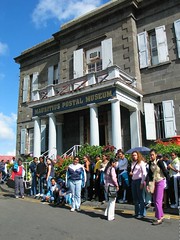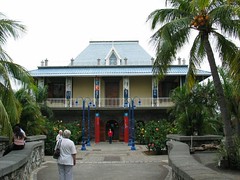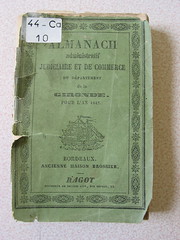Site content
Researching the "Post Office" Mauritius
Originally published in Philately From Australia, vol.56, no.2, June 2004, pp.26-30. First published online August 2006.
I first encountered the story of the famous 'Post Office' stamps of Mauritius on a visit to that island in January 2000, in the little postal museum, down by the harbour of Port Louis, Mauritius's capital. The heat and humidity of a tropical summer day had taken its toll and my husband and I were too tired to study the wall of thematically arranged stamps. But a short 'biography' caught my eye. An art historian and archivist by training and profession, I was intrigued by the story of the French schoolboy who, in 1902 after reading of the stamps' rarity and value, astutely searched through the archived correspondence of his father's old wine importing firm in Bordeaux, knowing they had done business with Mauritius back in the 1840s. He discovered three specimens of the stamps, famous for the supposedly erroneous inscription of 'office' for 'paid'. Both a one penny and two pence were affixed to a letter that is now one of the most highly prized items in the world of philately.
Much, I later discovered, has been written and researched about the 'Post Office Mauritius'. Indeed, almost from the moment of their discovery in France in the 1860s and for much of the twentieth century, they have been considered the most expensive and famous stamps in the world. It is a story well known to philatelists, but also, it seemed to me, a story ripe for a wider telling beyond the philatelic literature. But was there anything more to be said or discovered about them?
Attempting to answer that question has proved an absorbing hobby over the last two and a half years, resulting in the beginnings of a manuscript in the narrative non-fiction genre. The book, with a working title of 'Post Office Mauritius: A Philatelic Tale of Fact, Fiction and Forgery', will be published in the UK in early 2006.
Background research
My methodology has involved a combination of philatelic and more general research. The National Library of Australia, in Canberra, for example, has a magnificent collection of more than a thousand printed works on Mauritius in their Mauritius collection dating back to the eighteenth century (accessible through the online catalogue by searching on the call number MAUR) - invaluable for building up a realistic picture of contemporary Mauritius around 1847 and later.
Also invaluable has been the power of the Google search on the World Wide Web. Although in my work as an academic I hear colleagues bemoan the tendency of students to think that all there is to know can be found through searching Google, it has certainly enriched my knowledge of how far the 'Post Office Mauritius' stamps penetrated the public consciousness during the twentieth century. The two pence stamp (at least) reached stellar heights after the purchase of a near perfect specimen by George V in 1904, garnering the name 'Blue Mauritius'. The phrase 'Blue Mauritius' came to mean something rare, the rarity sometimes due to an error. In Germany at least, this phrase is still current. Fish, flowers, a shade of marine paint, a BMW model, even a blue potato - all have been named in honour of the two pence 'Blue Mauritius'. From the 1890s onwards the 'Post Office' stamps also seized the imagination of fiction writers, including such 'gems' as Billy Bunter and the Blue Mauritius in the 1950s and an episode of the TV series The Avengers. It was also through searching Google online that I discovered Vikram Chand's passion for the stamps of Mauritius, and the Chand A and Z Research Fund for Classic Philately administered by the British Library.
Royal Philatelic Society of Victoria
I needed to venture into the world of philately to take the research any further, and my entree to the Royal Philatelic Society of Victoria came via a chance meeting with Gary Watson at a stamp fair at the Malvern Town Hall. He invited me to an RPSV meeting, and there introduced me to Mauritius collector John Shawley. I have been a member of the Society ever since.
For much of 2003 I relished the benefits that membership bring, the sharing of information and particularly access to the library collections. Through John's own collection and that of the RPSV I have managed the basic and essential task of reading most of what has been written to date (in English) on the 'Post Office' stamps. Being able to borrow the journals (a luxury denied researchers in academic libraries) meant that I could at leisure immerse myself in the earliest days of philately through the pages of The Philatelic Record and The Philatelist, and trawl in-depth through magazines such as Stamp Collecting and the Stamp Collector's Fortnightly.
Research in Mauritius
In July 2003 I returned to Mauritius for a few weeks holiday and a few weeks research, the perfect combination. Since my last visit the purpose-built Blue Penny Museum had opened in Port Louis, its star attractions the fine unused specimens of the one penny and two pence 'Post Office' purchased in 1993 by a private consortium of sixteen Mauritian companies from the break up of Kanai's great collection for US$2.3 million. Unable to convince my jetlagged travelling companions to make the museum their first priority, it was three days after I arrived before I finally saw my first 'Post Office' stamps! Alain Huron, curator of the museum, kindly made copies of all the newspaper publicity the stamps had attracted in the world's press since 1993, and also took me out to the Port Louis cemetery to see the grave of Joseph Barnard (the stamp's engraver).
Once again, members of the Mauritius Philatelic Society were most supportive of the project, and Mico Antoine, secretary of the Society, took me in hand and walked me around the key sites of the 'Post Office' story in Port Louis, even taking me to meet the current Postmaster-General of the Mauritius Postal Services. I met with him most Tuesdays of my five week stay to discuss the progress of trips to the National Library and National Archives of Mauritius.
At the archives I concentrated on contemporary records from the 1840s, also following through on the story of a postal clerk, Moutoussamy Appavou. As the one character whose physical presence (at least) put him at both the birth of the stamps in 1847 and Major Evans's important discoveries in the island in the 1870s, Moutoussamy fascinates me. He began work in the Port Louis post office in 1839, undoubtedly handled the 'Post Office' stamps in the course of his daily work, and was still engaged as a clerk in that department in the late 1870s, when Evans was undertaking his research. What Moutoussamy had to relate of this important period in the island's postal history is anybody's guess, because nobody asked him. I believed he might be the employee referred to in one of the Revd C.S. Morton's articles on Mauritius in the Stamp Collector's Fortnightly in the 1920s, and his situation was an interesting one through which to examine the Mauritian postal system in the 1840s.
As an archivist, I am keenly aware of the role of records and recordkeeping in research, but I missed an opportunity here in Mauritius. It wasn't until some time later, as I was reading the French philatelic journals from the 1860s that I realised that key collectors and philatelists such as Herpin, Moens and Legrand corresponded with the postal authorities at Mauritius for information about stamp issues. Could any of this correspondence be preserved in the archives? I am hoping that Mico Antoine will be able to investigate this for me.
Research in London and Bordeaux
In September 2003 I travelled to London and Bordeaux courtesy of the Chand A and Z Research Fund for Classic Philately. Many members of the RPSV will know the delights of the London Society's library (for me particularly it was the rare French periodicals, and access to indexes), and my visits there reinforced the lesson of the good rummage. On a previous visit, John Shawley had been unable to locate a journal I was particularly interested in, La Philateliste Francais, the journal of Theophile Lemaire, which contained the story of the 'Post Office' stamps that reputedly inspired the French schoolboy to begin his hunt. It was not catalogued as being held in the RPSL's collection; however, I accidentally came across it while browsing the compactus in the basement.
While in London I had several consultations with David Beech at the British Library about the project, and examined the papers of the stamps' main biographers, the late Williams brothers. The papers were a little disappointing, as they seemed incomplete (i.e. not containing all correspondence referenced in their books, unless I missed something), although I still found some useful material in them. It was good to see the sources for some of their assertions and find the speculation on some of the canonical 'Post Office' being thought forgeries.
In Bordeaux I visited the Bordeaux Municipal Archives. My main interest was to investigate and test the truth of various elements of the Bordeaux discoveries of Madame Borchard in the 1860s and the Bordeaux schoolboy in 1902. I have had doubts about aspects of these stories as reported in the literature, but my research allayed these to a certain degree, using a combination of almanachs, annuaires and census information; for example, Adolphe Borchard did die in 1869 (27 February 1869), Albert Coutures existed, and so on. In the woefully short time I had left at the Bordeaux Municipal Library, I skimmed through the newspaper the Memorial Bordelais for 1847, and found a link between the Borchards (Madame Borchard found around half of the known specimens of the 'Post Office' stamps in her husband's correspondence in the 1860s) and Mauritius. Adolphe Borchard was a ship broker, and sent (and no doubt received) a number of consignments to Mauritius in 1847-48, during the brief period of the 'Post Office' stamps' life.
A 'Post Office' in Australia?
Several times I have come across reference to 'Post Office' stamps being discovered in Australia. In 1913 'an old lady who formerly resided in Mauritius' found a specimen in Perth, but the specimen was not found to be true. Late in the stamps' centenary year (1947) another one penny 'Post Office' was found by Mr R. Haydock, a stamp dealer in Perth, but the Williams brothers in London, who had been studying the history and provenance of the 'Post Office' for some years now, on being shown a photograph of the stamp declared it a forgery. Perhaps it was the same stamp documented in the Australian Stamp Journal back in 1913.
One of my favourite definitions of philately describes it thus: 'the collection and study of any one or more countries or issues whereby definite conclusions are arrived at, in spite of the absence of official records' (A. Crippa, 'Stamp Collecting and Philately', Stamp Collecting, 1924). The theme of how fact and myth have accumulated around the 'Post Office' story drives my research, for much of the story is rich in mystery, muddled in detail, and ripe for picking over. I would be happy to hear from any readers with an opinion on the 'Post Office'!


